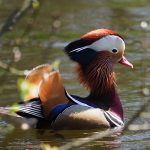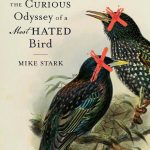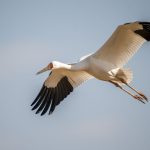Saturday was set aside for birding. Redgannet was in town and had all day to get out looking for birds so I had booked us for the pelagic trip out of Freeport and our plan was to find his life Snowy Owl and then get on the boat and enjoy a host of alcids, gulls, and gannets. Like all good plans this one did not come to pass as huge waves caused the cancellation of the pelagic trip. We switched up our agenda and decided to join Seth and Gene and a trio of Staten Islanders on a trip around Long Island looking for lingering rarities and anything else that we might manage to come across on a full day’s birding.
Black-capped Chickadee Poecile atricapillus
We started out on the east end of the Long Island’s north fork, searching the water’s off the Marion Causeway for the Barrow’s Goldeneye that has spent several recent winters there associating with its Common Goldeneye cousins. While Mr. Barrow declined to show we did see a host of scoters and loons so the stop wasn’t a total loss. Our next stop was Orient State Park where a Sedge Wren had been found on the Orient Christmas Bird Count and refound a couple of times since but we struck out on that bird as well. It seemed that the large amount of rainfall we had during the week made the marshy area that the wren had been found in too wet for its tastes. I had to content myself with my first Black-capped Chickadees for the year in New York, though the American Bittern I inadvertently flushed was nice as well.
Long-tailed Duck Clangula hyemalis
Other goodies at Orient State Park included lots of male Surf Scoters courting a few females, Long-tailed Ducks, Red-breasted Mergansers, White-winged Scoters, and a host of our common gulls that we fruitlessly scanned trying to turn up a rarity. Having gone zero-for-two on our twitches we started to make our way back west, stopping every time we saw large flocks of Canada Geese to see if we could find any rare geese mixed in with them. The best we could come up with was a Blue Goose, that is, the blue form of Snow Goose though the field that held that goose also had exactly one gull, a Lesser Black-backed Gull.
Surf Scoter Melanitta perspicillata
Our next stop was at the Mountain Bluebird spot so that we could find the bird for our Staten Island contingent. Intelligence from other birders who had been on the scene earlier let us know that the bird was being seen north of its usual haunts, and, sure enough, that is where we found the long-staying New York rarity. Two of our party also spotted what they were pretty sure was the Northern Shrike that has been in the vicinity but they did not get great looks and the bird refused to be refound.
Ring-necked Pheasant Phasianus colchicus
A quick drive through the Calverton grasslands netted us virtually nothing, though shortly after exiting we did come across the cock pheasant in the image above. We made a fast-food stop before finally making our way to Shinnecock Inlet where a Snowy Owl had been around for days and we also hoped to find other good birds in the inlet. The owl, much to Redgannet’s dismay, was a no-show. We did see large numbers of Common Eiders, a small flock of Bonaparte’s Gulls, and a bunch more seaducks. Driving down Dune Road hoping to find another bittern did not turn up our quarry but a total of fifteen (!) Great Blue Herons and a lingering Great Egret were all a pleasure.
near the end of the day at Jones Beach
At this point we made a beeline for Jones Beach, after wishing the Staten Islanders a fond farewell, because the Snowy Owl there has been reliable and we couldn’t take Redgannet’s incessant weeping anymore. Unfortunately, the usually rock-solid snowy at Jones Beach was not in evidence and we had to continue to listen to Redgannet crying as we made our way over to Point Lookout in the hopes of finding something good for the end of the day.
The wind was getting colder and the sun was getting lower as we wandered along the Jones Inlet at Point Lookout. Our last good birds of the day were the trio of Harlequin Ducks – two females and a male – that have been there for most of the winter.
Harlequin Ducks Histrionicus histrionicus
While we did not find Redgannet his Snowy Owl we did have a darn good day birding the fertile habitat of Long Island. And, really, if we had found all the birds we wanted to see what fun would it have been?
sunset at Point Lookout
…


















What, no gannet for Redgannet? And not even a Snowy Owl? Hmmmm, that might just be a devilish plot of one Corey Finger in the year list competition, just in case Redgannet decides to join in. 🙂
And that pheasant might speak Japanese, in part, no?
I used to live out in East Marion, and saw my life-only Snowy Owl at Orient State Park. Good days.
@Jochen: Of course we had gannets – they are a given along the south shore of Long Island in winter. And whatever that pheasant speaks, it isn’t American English…
@Naomi: Sure would have been nice to have one on Saturday!
I’m not expecting to get Snowy Owl on my list! Actually I may not even get all those cool birds in Heidelberg! Once we all have our lists at the end of the year we should see how many species all the Beatwriters get-could we get near 10,000?! 🙂
@Corey: the pheasant just looks awefully green on the neck to be a pure colchicus (of freely combined subspecies). Do you occasionally get P. veriscolor in North America mixed into the “hunting bag”?
@Clare: Somehow, I think that 4,000 or so might be where we top out.
@Jochen: I honestly don’t know but I imagine that anything that folks could find to shoot, they brought over to do just that.
I think the idea of combining year lists of the beat writers is great. You could start a contest among the readers to see who guesses closest.
“Sob”